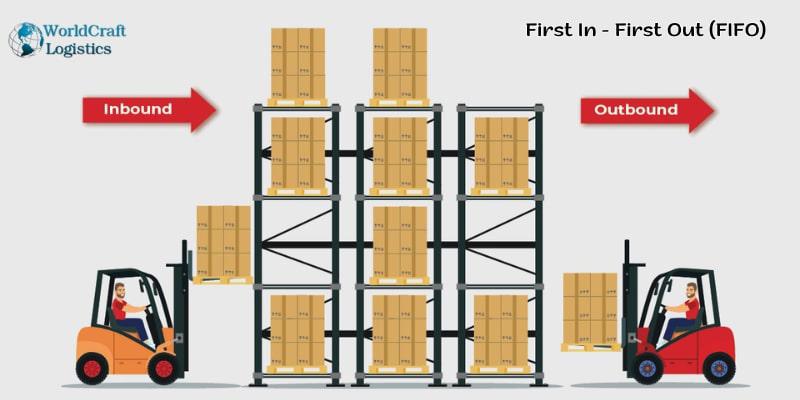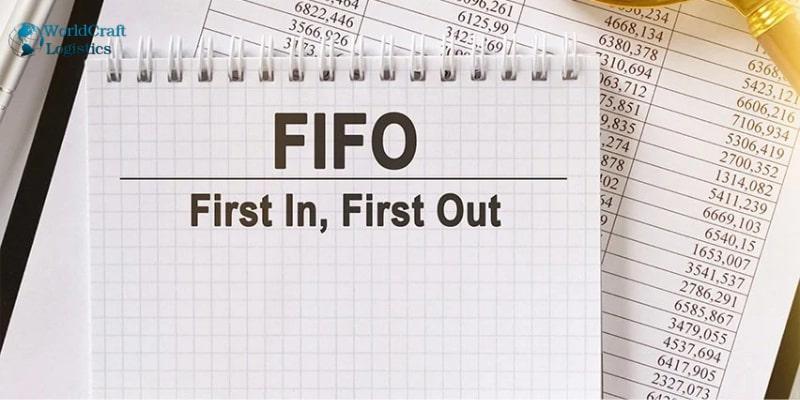
Starting June 1st, 2023 Our warehouse fee will be $0.65/cubic foot per month
In effort to lower the warehouse storage fee during inflation, we have went narrow aisle racking.This construction took us four months but the project is finally completed. With narrow aisle racking, we are able to drop storage by 24%.We as partners will go through this inflation together.
10/09/2023
First in, first out — or FIFO — is an inventory management practice where the oldest stock goes to fill orders first. That way, the first stock purchased/received is the first to leave. FIFO is also an accounting principle, but it works slightly differently in accounting versus in order fulfillment.
Inventory management is critical to managing your eCommerce business. Smart inventory planning can make a big difference in your cash flow and profit margins. So, understanding the concept of FIFO is essential. The FIFO method can help you more accurately account for the cost of goods sold (COGS). It could also help reduce your eCommerce fulfillment costs.
FIFO is a way of handling goods in a fulfillment warehouse, but it’s also a method of accounting for the movement of goods sold in and out of inventory. Here’s a breakdown of these two types of FIFO.
Utilizing the FIFO (First In First Out) method in supply chain management offers numerous advantages.
Perhaps the most obvious benefit is that it can help to avoid product waste. In situations where products have a limited shelf life prioritizing their usage through implementing the FIFO strategy can prove to be a smart choice. This approach not only ensures efficient consumption but also minimizes waste by utilizing them before its expiry date.
In addition, FIFO can help to ensure that products are available when customers need them. For products with extended manufacturing periods, timely delivery becomes crucial for customer satisfaction. To achieve this, adopting the FIFO approach guarantees prompt shipping and delivery.
Using FIFO can help to build good relationships with suppliers. The assurance of prompt product usage may stimulate suppliers to extend discounts or other benefits. In addition, if there are any issues with a product, knowing that it will be used quickly can motivate suppliers to resolve the issue quickly so that future orders are not affected.

FIFO, or First In First Out, is one of the most popular methods for managing inventory in the warehouse. When implementing FIFO, items are placed in the warehouse in the order that they are received, and when an item is needed it is taken from the oldest stock first. This system ensures that inventory does not become outdated and keeps the warehouse organized.
There are a few different ways to implement FIFO in the warehouse. One common method is to use separate storage areas for each product type. When a new shipment of an item arrives, it is stored in the correct area and date-stamped. When an item is needed, it is taken from the oldest section first. The adoption of this system mandates an elevated level of organization from employees working in the warehouse. Nevertheless, its efficacy cannot be understated.
Another way to implement FIFO in the warehouse is to use storage shelves that are labeled with dates. In this method, a systematic placement process will be implemented wherein items are arranged on the shelf in accordance with their arrival time. Newly arrived products are put at the back while older ones occupy the front positions. This methodology allows staff members to easily access required products without having to scour through various warehouse sections.
Irrespective of the method employed, implementing FIFO in your warehouse can help to improve your supply chain management and keep your inventory organized.

An example of FIFO is the best way to understand the FIFO approach to inventory. Let’s take the case of Garden Gnome, a (fictional) online retailer of gardening supplies and equipment. In January, Garden Gnome ordered 50 trowels at a wholesale price of $10 each. The store sold 25 trowels in January and ordered 75 more in February. For the second order, the wholesale price had risen to $11. By the end of the first quarter, the eCommerce company had sold 75 trowels and had 25 still in stock.
Using FIFO accounting, the COGS of the remaining 25 trowels is $11 each, or $275. The calculation for the COGS of the inventory that sold looks like this:
(50 x $10) + (25 x $11) = $775
In other words, using the FIFO inventory valuation method, Garden Gnome assumes that the first trowels to sell were the first ones bought, with a lower wholesale price. Once the original 50 are sold, the company records the COGS for additional trowels at the higher wholesale price. That cost method is more accurate than using the average cost to determine inventory value.
As prices fluctuate throughout the year, FIFO inventory accounting helps Garden Gnome keep track of its true cost of goods sold. That allows it to set retail prices that accurately reflect costs and maintain healthy profit margins. In addition, the company uses FIFO warehouse management. That reduces the chance of getting stuck with outdated stock if a manufacturer changes a product style.

Companies rely on FIFO inventory management to keep their supply chains running smoothly. By implementing FIFO, corporations can guarantee that they are achieving maximum efficiency with their inventory. Moreover, their merchandise remains in top condition. Here are some best practices for FIFO inventory management:
Businesses must prioritize the maintenance of meticulous records detailing their inventory levels. By doing so, they can make informed decisions surrounding supply replenishment and avoid the downsides associated with overstocking.
Proper storage is essential for keeping your products fresh and preventing damage. It is of utmost importance that you store your products in a cool and dry location, one that is inaccessible to direct sunlight or heat.
Regularly inspect your products for signs of damage or spoilage. By staying on the lookout for signs of trouble and promptly addressing any concerns that arise, you can preemptively curtail issues from snowballing into more significant problems down the line.
Assumptions about the “bullwhip effect” and FIFO cost flows
In an ideal world, demand is steady, and your supply chain moves at a predictable pace, providing a steady flow of goods from factory to fulfillment warehouse to customer. Of course, after recent supply chain disruptions, it’s abundantly clear that we don’t live in a perfect world.
Consumer demand can spike or change, causing what RSF’s Arnold calls the “bullwhip effect.” In the bullwhip effect, instead of a straight line of products being pulled toward the end consumer, your supply chain gets distorted, like cracking a bullwhip. These distortions ripple through fulfillment, transportation, and manufacturing.
The cost flow assumption built into FIFO is that you’ll sell older goods first. When you experience the bullwhip effect, that cost flow assumption may get complicated, particularly if older merchandise becomes unsalable because of changes in consumer preferences.
“The objective of any retailer, manufacturer, anyone in the supply chain, is to make the bullwhip effect as smooth as possible,” Arnold says. He notes that some amount of bullwhip effect may be unavoidable at certain times or for specific industries. Improving your demand forecasting is an excellent way to reduce this disruptive phenomenon.

"FIFO vs. LIFO is always trying to optimize costs or movement of goods” Arnold says. You should use whichever method works best for your business.
FIFO: First products to arrive are the first products sold/taken out of stock. Simplest method, especially for products quick to spoil.
LIFO: Last products to arrive are the first products sold/taken out of stock. Used to reduce net income and therefore a company’s tax bill. Controversial method used only in the U.S.
Keep in mind that each method is technically used for valuation purposes. Your inventory accounting method may not always reflect your actual inventory flow. Rather, a given method is used to assume the associated costs of a product.
The United States is the only country that allows last in, first out (LIFO) inventory accounting. LIFO is accepted under the Generally Accepted Accounting Principles (GAAP). Other countries, which use the International Financial Reporting Standards, do not.
As you can imagine, first in first out is perhaps the simplest and most acceptable method. Applying FIFO ensures your inventory is an accurate reflection of reality and limits the possibility of your books coming under scrutiny by regulators or tax authorities.

“Inventory that has not been produced in a timely manner to satisfy demand is an improper use of funds,” Arnold says. “On the macroeconomic level, in the grand scheme of things, dollars should be deployed where they’re actually generating value.” He notes that companies holding too much stock are “penalizing themselves by not deploying that capital elsewhere.”
Failing to rotate and turn over inventory can hurt your bottom line by incurring long-term storage fees. Some 3PLs charge higher rates for stock that stays on the shelf for more than 180 days, or more than 365 days, as an incentive for clients to optimize inventory and storage.
For example, if the Garden Gnome online store has 50 trowels in stock and has sold a total of 150 over six months, it won’t incur long-term storage fees because its stock has turned over three times. That’s true even if it uses the LIFO method and a few of those trowels have been at the back of the shelf for a long time. On the other hand, if Garden Gnome only sold 30 trowels in 180 days, its 3PL might charge a long-term storage fee for the 20 extra trowels on hand. Plus, that excess stock could be a sign that the online garden shop should keep no more than (and maybe less than) 30 trowels in inventory.

Inventory management is complex, and getting it right is essential to building a thriving eCommerce business. When you choose Worldcraft Logistics as your 3PL, you add experienced professionals to your team. We can help you determine optimal inventory levels, add visibility to your supply chain to improve operations, choose between FIFO vs. LIFO methods, and keep your storage costs as low as possible.
The FIFO method rule is that the first inventory items put on the shelf should be the first ones taken off the shelf to fill an order. The FIFO method is particularly critical for perishable items such as food, which can go bad if not sold quickly enough.
To implement FIFO warehousing, warehouse managers typically use pallet racking systems designed for FIFO management. These systems, also known as gravity flow racking systems, allow warehouse employees to feed goods into one end of a rack and retrieve it from the other end when needed, ensuring that the oldest pallet is always the first one removed.
FIFO warehousing reduces spoilage by ensuring that the oldest inventory items are sold first, thereby decreasing the risk of items expiring or becoming obsolete before they can be sold. Furthermore, FIFO warehousing, particularly when implemented using pallet flow racking systems, allows for denser packing of goods, thereby maximizing warehouse space usage.
A wide range of businesses can benefit from FIFO warehousing, including those in the food and beverage industry, the apparel industry, the pharmaceutical industry, and the electronics industry. In these sectors, products often have a risk of spoiling, becoming obsolete, or needing to keep up with changing trends, making FIFO an effective inventory management strategy.
The article answers what is FIFO in supply chain management, and other useful information. In Worldcraft Logistics' personal opinion, the FIFO method increases productivity levels while reducing overhead costs, allowing businesses to maintain flexibility in a competitive environment. Capturing these benefits and designing appropriate strategies with FIFO integration is essential for long-term survival, especially in the logistics sector. Stay tuned for new upcoming topics with us.
SEO
Digital Marketing/SEO Specialist
Simon Mang is an SEO and Digital Marketing expert at Wordcraft Logistics. With many years of experience in the field of digital marketing, he has shaped and built strategies to effectively promote Wordcraft Logistics' online presence. With a deep understanding of the logistics industry, I have shared more than 500 specialized articles on many different topics.

Education
01/05/2025

Education
02/18/2025

Education
01/01/2024

Education
08/28/2024

Education
11/13/2023